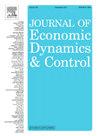Accounting for the multiple sources of inflation: An agent-based model investigation
IF 2.3
3区 经济学
Q2 ECONOMICS
引用次数: 0
Abstract
We develop a macroeconomic agent-based model to study the role of demand and supply factors in determining inflation dynamics. Local interactions of heterogeneous firms and households in the labor and goods markets characterize the model. Asymmetric information implies that firm selection is imperfect and depends both on firms' relative prices and on their size. We calibrate the model on EU data by using the method of simulated moments and show that it can generate realistic inflation dynamics and a non-linear Phillips curve in line with recent empirical evidence. We then find that the traditional demand-led explanation of inflation stemming from a tight labor market only holds when selection in the goods markets is mostly driven by relative prices in comparison to firm size. Finally, we study the response of inflation to shocks impacting consumption, labor productivity, or energy costs. The results indicate that only demand shocks lead to wage-led inflation surges. Productivity shocks are entirely passed through to prices without affecting the income distribution. Energy shocks, instead, induce sellers' inflation after changes in both firms' cost structure and profit margins. This is in line with the recent empirical evidence for the Euro Area.
考虑通货膨胀的多重来源:一个基于主体的模型研究
我们开发了一个基于宏观经济主体的模型来研究需求和供给因素在决定通货膨胀动态中的作用。异质企业和家庭在劳动力和商品市场中的本地相互作用是该模型的特征。信息不对称意味着企业选择是不完美的,取决于企业的相对价格和规模。我们使用模拟矩的方法在欧盟数据上校准模型,并表明它可以生成现实的通货膨胀动态和符合最近经验证据的非线性菲利普斯曲线。然后,我们发现,传统的需求导向的通货膨胀解释源于劳动力市场紧张,只有当商品市场的选择主要是由相对价格与企业规模的比较驱动时,这种解释才成立。最后,我们研究通货膨胀对影响消费、劳动生产率或能源成本的冲击的反应。研究结果表明,只有需求冲击才会导致工资引发的通胀飙升。生产率的冲击完全传递给了价格,而不影响收入分配。相反,在两家公司的成本结构和利润率发生变化后,能源冲击引发了卖方的通胀。这与欧元区最近的经验证据一致。
本文章由计算机程序翻译,如有差异,请以英文原文为准。
求助全文
约1分钟内获得全文
求助全文
来源期刊

Journal of Economic Dynamics & Control
ECONOMICS-
CiteScore
3.10
自引率
10.50%
发文量
199
期刊介绍:
The journal provides an outlet for publication of research concerning all theoretical and empirical aspects of economic dynamics and control as well as the development and use of computational methods in economics and finance. Contributions regarding computational methods may include, but are not restricted to, artificial intelligence, databases, decision support systems, genetic algorithms, modelling languages, neural networks, numerical algorithms for optimization, control and equilibria, parallel computing and qualitative reasoning.
 求助内容:
求助内容: 应助结果提醒方式:
应助结果提醒方式:


